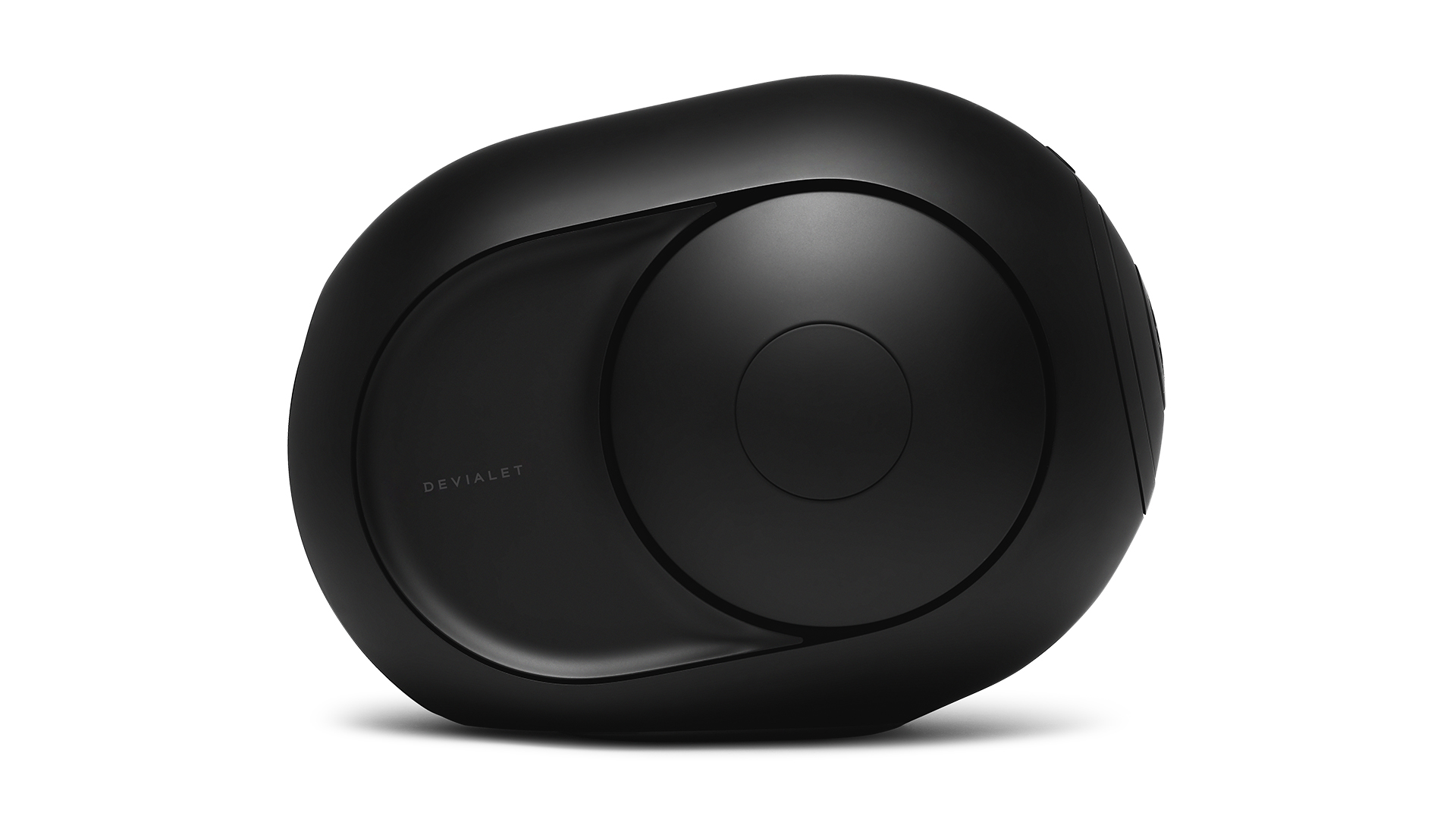What Hi-Fi? Verdict
A powerful, striking and truly one-of-a-kind wireless speaker, but not the most entertaining one at this level
Pros
- +
Big, broad, room-filling sound
- +
Heart-in-your-mouth bass
- +
Striking aesthetic
Cons
- -
Lacks transparency and subtlety
- -
App isn’t a UPnP controller
- -
In-app multi-room flakiness
Why you can trust What Hi-Fi?
Despite having welcomed many Devialet Phantom wireless speakers into our test rooms over the past few years, we still find ourselves struck by the beauty and bass reproduction of the latest iteration.
This new flagship Phantom I brings with it a simplification and expansion of the iconic, brand-defining line: the compact Phantom Reactor is now ‘Phantom II’ (in 95dB, 98dB and special-edition Opéra de Paris models), above which sits the ‘Phantom I’ (in 103dB, 108dB and Opéra de Paris variants).
Devialet has now introduced a £349 ($350) Arch configurable connectivity hub for Phantom too, giving owners the option to add sources (including a turntable) either via its built-in phono stage and RCA line-level inputs, or alternatively two coaxial digital inputs.
Features

Without that accessory, the Phantom I is reliant upon a network, with support for AirPlay 2, Spotify Connect, UPnP and Roon (both up to 24-bit/96KHz) over ethernet or wi-fi, although there is Bluetooth onboard, as well as an optical input (up to 24-bit/96KHz) at the rear.

Power output 1100W
Airplay 2 Yes
Spotify Connect Yes
Bluetooth Yes
Roon Ready Yes
Dimensions (hwd) 25.5 x 25.2 x 34.2cm
Weight 11.4kg
The decibel ratings attached to the names represent their maximum sound pressure level at one metre – something that sets Devialet Phantoms apart not only from one another but most of their competition, considering they can go between the approximate relative loudness of a lawnmower and a chainsaw.
The sample on test here is the Phantom I 108 dB, which is available in dark chrome or white/gold finishes and covers a claimed frequency range of 14Hz to 27kHz. The Phantom I 103 dB, meanwhile, comes in light chrome or matte black and encompasses a slightly narrower bandwidth (16Hz to 25kHz).
Many of Devialet’s patented technologies are present in the new Phantom I, including its ADH (Analog Digital Hybrid) amplification, designed to combine the benefits of Class A analogue (high performance) and Class D (high efficiency and power) designs.
The latest hi-fi, home cinema and tech news, reviews, buying advice and deals, direct to your inbox.
At the risk of using too many acronyms, HBI (Heart Bass Implosion) represents Devialet’s efforts to produce deep, impactful bass from the compact enclosure; its ACE (Active Cospherical Engine) design takes care of outputting sound evenly in various directions from the spherical chassis; and Speaker Active Matching (SAM) processing works to optimise the signal and performance in real-time.
Such patented technologies have been part of the Phantom line-up from the start, but the new Phantom I aims to take performance further with a next-generation system-on-chip and improved thermal dissipation (it’s four times more energy-efficient than the previous model).
Build

The Phantom’s iconic, visually striking spherical design, which we’ve likened to an ‘Alien bug’ and ‘Storm Trooper’s lunchbox’ lives on, but not totally unchanged. It’s now like a miniature jet engine, with a matte finish, new signature side panels and LED status lights at the rear – it’s eye-catching in the best way possible.
The Phantom I comes with a new puck-like remote that’s as other-worldly and premium as the speaker aesthetic and price deserves, too. We like how you rotate the whole outer ring to change volume (you can also play/pause and skip tracks with the central touchpad), although ergonomically it doesn’t feel all that natural in the hand to do so.
The alternative is Devialet’s dedicated app, which provides similar playback functions, as well as settings such as ‘AV sync’ for reducing latency if you’re using the Phantom I with your TV via its optical input, and ‘Night mode’ for sucking some of the bass out of the performance (which it does effectively, too).
Somewhat disappointingly, the app doesn’t also serve as a UPnP streaming controller, so those wanting to access local or networked files or music services will need to use the paid-for Roon platform (the Phantom I is Roon Ready), or download another third-party UPnP app such as BubbleUPnP (Android) and mconnect Player (Android, iOS), both of which are perfectly usable free apps.
We’re also a little let down by the app’s imperfect multi-room and stereo pairing experience, which in our testing proves occasionally flaky by not displaying the connection, or doing so but not initiating through the speakers. If you’ve spent several thousands on a multi-room wireless speaker set-up, you are perhaps entitled to expect seamlessness.
Sound

You also expect a ‘wow’ performance, which in some areas the Phantom I delivers. This is one of the clearest, most bassy and broadest-sounding single-chassis wireless speakers we've come across since the previous full-sized Phantom we tested.
For a wireless speaker of its size, Devialet’s latest can, like the iterations before it, excavate a bass line. The jaunty electro-funk lows underpinning Childish Gambino’s 19:10 are deep and impactful – and visually represented by the enthusiastically pumping side-firing drivers. Play something denser such as 65daysofstatic's Retreat! Retreat!, and it’s not afraid to get down and dirty with the cacophony of drums and electrics while ensuring they don’t bog down the whole presentation.
The Phantom I produces a broad, open soundstage that far belies its compactness. If you're looking for the biggest sonic footprint from a small physical one, a single Phantom I can output more than is necessary to fill most living rooms. But, while one of the Devialet’s unique selling points is its spectacular power output, the presentation ultimately becomes harsh and, consequently, less listenable when really pushed.
Such is the Devialet’s midrange clarity that upon hearing it for the first time, you’ll want to queue up songs by your favourite vocalists. We find ourselves doing just this; Nina Simone, Aretha Franklin, Bob Dylan, ANOHNI, and The Tallest Man on Earth’s Kristian Matsson come through with purity and polish. But it isn’t long before we realise that such tangibility isn’t complemented by the levels of transparency we’d expect at this price – and especially from a Phantom.
While the Phantom I can distinguish between a soprano and a piano, it’s only able to draw the silhouette of a vocal or instrument rather than reveal any of its colour or shading. It doesn’t rise and fall with Simone’s dynamic delivery, nor does it get under Matsson’s subtle inflections.
We play Ludovico Einaudi’s piano-led Oltremare, and while the notes float across a soundstage that, if you closed your eyes, could pass for one from stereo speakers placed close together, there isn’t the dynamic insight or finesse necessary for you to thoroughly appreciate the variation in his masterstrokes.
We find ourselves creeping the volume up in an effort to feel more involved in the piece – a sign of a performance that falls short of captivating. For the Devialet’s not insignificant asking price, we expect more in the way of sonic sophistication.
Verdict
Devialet’s original Phantom arrived at a time where wireless speakers were slowly but surely maturing into the high-end market. Today, that premium space is more competitive, and with it, the level of performance has improved too.
You’ll struggle to find another that can fill a room or dig up a bass line quite like the Phantom I, but your search for a wireless solution – single-box or otherwise – capable of more insight for the money will be easier. The Phantom I remains a one-of-a-kind option with undisputed talents, but overall its performance leaves us a little cold.
SCORES
- Sound 3
- Features 4
- Build 4
MORE:
Read our guide to the best wireless speakers
Read our Devialet Gold Phantom review
What Hi-Fi?, founded in 1976, is the world's leading independent guide to buying and owning hi-fi and home entertainment products. Our comprehensive tests help you buy the very best for your money, with our advice sections giving you step-by-step information on how to get even more from your music and movies. Everything is tested by our dedicated team of in-house reviewers in our custom-built test rooms in London, Reading and Bath. Our coveted five-star rating and Awards are recognised all over the world as the ultimate seal of approval, so you can buy with absolute confidence.

